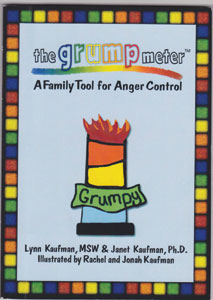 Sometimes uncontrolled anger in children and teens can lead to the one event that parents, teachers, doctors and friends cannot fix — suicide. Lynn Kaufman, who has a master’s degree in social work, has devoted the last 22 years helping children and families talk about their anger, become aware of their angry moods, recognize oncoming anger signs and control their angry behaviors.
Sometimes uncontrolled anger in children and teens can lead to the one event that parents, teachers, doctors and friends cannot fix — suicide. Lynn Kaufman, who has a master’s degree in social work, has devoted the last 22 years helping children and families talk about their anger, become aware of their angry moods, recognize oncoming anger signs and control their angry behaviors.
“I found the issues around families and children very interesting,” said Kaufman. “I am interested in how relationships among people work. I am interested in children and families learning to control their anger and express it in positive and constructive ways. I am interested in people in a family understanding each other’s anger so that each member of the family has ways to be known and understood.”
This interest first brought her to KVC Behavioral Health Care in Wyandotte County in 1990. The focus of the treatment center was “anger control.” Although the social workers were following a program on anger control developed by Arnold Goldstein, Ph.D., Kaufman decided that something more was needed.
“I decided that children would benefit from a tool that would help them identify their angry moods and escalating anger,” she said. “I developed the Grump Meter and immediately saw how children used it and how it helped them identify their anger and put words and new thoughts to their angry moods.”
She then started using the Grump Meter to teach anger control to families. Families were encouraged to acknowledge anger, frustration and fear connected to aggressive and destructive behaviors.
“To my surprise,” she added, “the parents loved the tool and wanted to use it with their children.”
The Grump Meter can be any size. It is basically a ruler with five categories, blue for calm; green for grumpy; yellow for caution; orange for stop; and red for explosion.
The tool became so helpful that Kaufman and her daughter, Janet Kaufman, Ph.D. decided to write a book. “The Grump Meter, A Family Tool for Anger Control,” so that many more families could use the techniques to help negotiate and manage their expression of strong feelings in new ways.
“I recognized immediately that the color and the simplicity of the book were very helpful to family understanding of anxiety, sorrow, grief, loss and anger,” said Kaufman. “The children were able to see from colors how they changed feelings during one day. This helped them be aware of where they were on the Grump Meter and to reach the goal of coming back to blue. The goal of the grump meter is to have a blue day and to avoid the ride to red.”
Besides helping children and their parents know where a child is on the Grump Meter, the book also provides ways to bring a child down from the danger zones of orange and red, and move back to the calmer green and blue zones.
Others are also aware of the impact Kaufman has made on the children in Kansas. In April she was honored by the University of Kansas as the 2012 Outstanding KU Social Work Alumna. In her nomination of Kaufman, Hildy Flanigan stated:
“In 2004, KVC opened a licensed hospital for preteens and teens. Lynn was the first social worker on that unit. Most of the children admitted to the hospital came with suicide ideation and/or attempts to end their lives. To help children find the language to understand their own life stories and find reasons to live instead of die, and to help them find language and their own creativity and courage, Lynn turned to literature, writing, group process family dialogue and behavioral approaches, including anger control.”
Kaufman said that 99 percent of children that she sees come in following suicide thoughts, feelings and actions.
“When shown the Grump Meter, they immediately point to red — the area of the most anger. They identify ‘red’ as the mood they were in when they attempted to end their lives,” said Kaufman. “Once they started to drop to orange and yellow and green, they have no thoughts of suicide. That change can take place within hours of admission to the hospital where the ‘work’ begins.”
“What is in their minds when they want to kill themselves?” Kaufman asks. “Why is this day different from all other days?’ The answer is that every child has an answer to the question and describes an issue or a story or a crisis that they cannot solve. They feel hopeless to find answers and in those moments, they see no other way to solve their problems. Once they see options and consider new thoughts, their need to die is decreased. Every single child who survives an attempt to end their lives is glad they are alive.”
Besides her work at KVC, Kaufman has also been an adjunct instructor for the KU School of Social Work and has been a field instructor for students for many years.
She and her husband, Andrew Kaufman, M.D. belong to The Temple, Congregation B’nai Jehudah. They are the parents of two daughters and four grandchildren. Two of the grandchildren also contributed to the book with the illustrations: Rachel and Jonah.
The “Grump Meter” is available from Amazon and from Kaufman’s website: www.grumpmeter.com.



